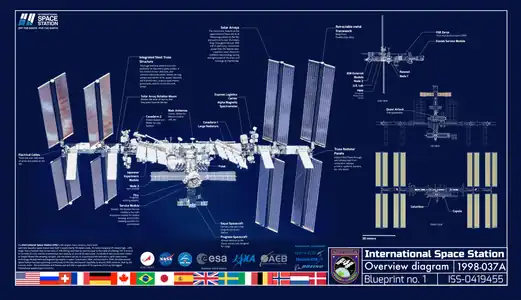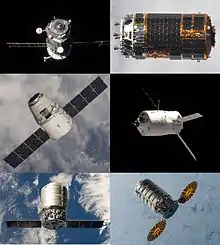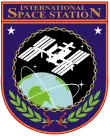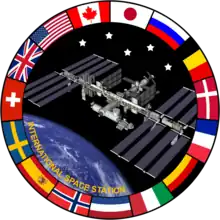| A Beautiful Planet | |
|---|---|
 Theatrical release poster | |
| Directed by | Toni Myers |
| Written by | Toni Myers |
| Produced by | Toni Myers |
| Narrated by | Jennifer Lawrence |
| Cinematography | James Neihouse |
| Edited by | Toni Myers |
| Music by | |
Production companies | |
| Distributed by | IMAX Entertainment[1] |
Release date |
|
Running time | 46 minutes[2] |
| Country | United States |
| Language | English |
| Box office | $25.7 million[3] |
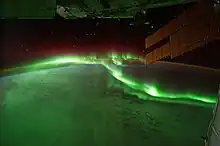
A Beautiful Planet is a 2016 American documentary film written, directed, and produced by Toni Myers and narrated by Jennifer Lawrence. It was originally released exclusively for IMAX theatres. Created in cooperation with NASA, the documentary uses footage recorded by astronauts aboard the International Space Station (ISS) over the course of fifteen months.[4]
The documentary examines how astronauts live and work on a daily basis. The astronauts represent the respective space agencies of the United States, Russia, Europe, and Japan.
The documentary premiered in Manhattan, New York City, on April 16, 2016, and made its theatrical debut on April 29, 2016. The film was first aired domestically only in the United States, grossing $15.6 million.[5] It was later aired in the United Kingdom, Australia, New Zealand, and Russia/CIS.[5]
Content overview
A Beautiful Planet uses large-scale cinema screens to display capital cities illuminated by skyglow,[6] lightning storms seen above clouds, Super Typhoon Maysak as seen from its eye, polar auroras viewed from low Earth orbit, the Great Lakes of North America locked in ice and snow, and reefs below the surface of the Caribbean Sea.
The film depicts views of space from the International Space Station (ISS) of geographical formations that may not be visible from the land such as Lake Manicouagan, an annular lake in Quebec, Canada.
Scenes from the documentary show a snow-capped segment of South America's Andes, the longest continental mountain range in the world. The Andes stretch from Venezuela north of the Equator, through the Tropics, and down to southern Argentina, and contain "some of the most extreme climate zones on earth [...] between "ice fields and deserts". The Andean Mountains include Aconcagua, the highest peak in The Americas, as well as the highest in the Southern Hemisphere.[7]
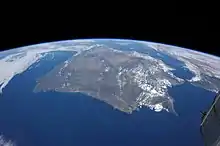
The movie presents Earth's driest and wettest areas with an overhead sequence of the Namib Desert on the east cleft by the Atlantic Ocean's Skeleton Coast in the west. The film repeats the consensus[8] that the Namib is the "oldest desert" on Earth, having a desert climate longer than any other region in the world, and being around tens of millions of years longer than the Sahara.[9]
The film begins with a light-years-long, computer-generated trip through swarms of stars in the Milky Way; the compressed trip ends with the Solar System.[10]

The film uses time-lapse photography to depict how Earth's warming climate is causing the Greenland ice sheet to melt, using footage of the Jakobshavn Glacier calving.
A Beautiful Planet also presents images of large-scale deforestation in Madagascar. The film shows how this island suffers from widespread soil erosion and habitat destruction of the island's native wildlife, such as the lemur. A Beautiful Planet also shows images of the burning of the Amazon rainforest.
The film depicts multiple scenes of climate change and environmental degradation. Filmmaker Toni Myers told the Los Angeles Times, "I wanted to inspire people especially as to how beautiful the planet is, how fragile it is, how complex and diverse and varied it is ... Most of all I wanted to show why we want to find solutions to look after our planet. It's our only one."[11]
Exoplanet Kepler-186f
The final scenes of A Beautiful Planet briefly examine the exoplanet Kepler-186f, which was discovered in 2014. It was the first planet found to be orbiting within its star's habitable zone with a mass similar to Earth.[12] Liquid water could conceivably exist in that orbital area without freezing or vaporizing. It was the first discovery of an Earth-sized planet on which life could reside.[13]
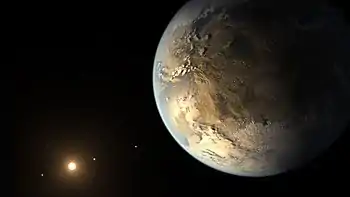
The name "Kepler" comes from its discovery by the Kepler Space Telescope, or "NASA Discovery Mission Number 10," a spacecraft observatory that is designed to find exoplanets in our region of the Milky Way Galaxy that are Earth-sized and smaller, and that are within the habitable zone.[14] The planet orbits Kepler-186, a red dwarf star[15] about half the size and mass of the Sun[16] that lies in the direction of the constellation Cygnus, about 500 light-years away.[17] The number "186" in the planet's name refers to the order in which its planetary system was discovered while scientists processed all of the data produced by the Kepler Space Telescope.[18]
Although interstellar travel to another planetary system like Kepler-186f is not feasible given current astronautics technology, some spaceflight futurists (like Samantha Cristoforetti) find value in speculating about the currently impossible.[19]
The astronauts
The film's cast reflects the diverse crew of the International Space Station. The astronauts who appeared in the movie included the following:
- Cristoforetti, Samantha: Spent more time in an uninterrupted spaceflight than any other European astronaut.
- Kelly, Scott: Spent roughly a year in space during a long, uninterrupted stay aboard the International Space Station.
- Lindgren, Kjell: A medical doctor who had previously worked as a flight surgeon supporting medical operations and space-station training at NASA's Johnson Space Center.[20]
- Shkaplerov, Anton: Commander of the Soyuz spacecraft that brought Cristoforetti and Virts to the Space Station.
- Virts, Terry: Commander of the 43rd expedition to the ISS from March 11, 2015 to June 11, 2015.
- Wilmore, Barry "Butch": Commander of the 42nd expedition to the ISS from November 10, 2014 to March 11, 2015.
- Yui, Kimiya: Designated as Head of the JAXA Astronaut Group after he returned from his stay on the Space Station.[21]
Research lab
The International Space Station is a scientific laboratory,[22][23] and many of the experiments on the ISS use the astronauts themselves as research participants to determine how spaceflight affects the human body. On March 28, 2015, Scott Kelly and Mikhail Kornienko arrived at the Space Station to begin a much-discussed one year mission to study the health effects of long-term space travel.[24] Scientists hoped to analyze their mission and discover ways future space explorers might adjust to the effects of weightlessness, isolation, radiation exposure, and stress they would encounter in a 30-month-round-trip expedition to Mars, or in an even longer trip beyond Mars.[25] Shortly after Kelly's arrival at the Space Station, A Beautiful Planet shows him participating in an initial examination of his eye, to study and correct any vision decline reported by many astronauts.[26]

Scott Kelly has an identical twin, Mark Kelly, who is also a retired NASA astronaut. The brothers agreed to be the subjects of an unprecedented twin study; Mark stayed on Earth during Scott's eleven months aboard the ISS so that researchers could examine how an extended spaceflight affected Scott's body compared to Mark's.[27] While Scott was in space and after he returned, both twins gave periodic blood samples and DNA swabs, and they underwent body scans and many other medical tests.[28] In the epilogue to his 2017 book about the year-long mission, Scott wrote that the very preliminary assessments of the data from the mission and from the twin study were promising:
The data is still being analyzed as I write this, and the scientists are excited about what they are seeing so far. The genetic differences between my brother and me from this year could unlock new knowledge, not only about what spaceflight does to our bodies, but also about how we age here on Earth. The Fluid Shifts study[29] Misha [Mikhail] and I did is promising in terms of improving astronauts' health on long missions. The studies I did on my eyes - which don't seem to have degraded further during this mission - could help solve the mystery of what causes damage to astronauts' vision, as well as helping us understand more about the anatomy and disease processes of the eye in general.
In the taste test phase of an experiment with space farming, Kelly and his fellow Expedition 44 crew-members Kjell Lindgren and Kimiya Yui are shown sampling red romaine lettuce that was grown in the Space Station's "Veggie" (or Vegetable Production) System. The Veggie series of experiments are designed to ensure that future explorers visiting the Moon, Mars or an asteroid have access to fresh produce and to provide them with an opportunity for relaxation and relief from stress or boredom.[31]
Earth observatory
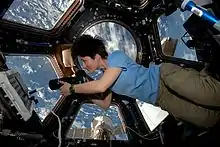
A Beautiful Planet provides close-up footage of the Cupola, a domed, 360 degree observation bay on the nadir (Earth-facing) side of the Station's Tranquility module / Node 3. It has seven windows in total, with six outwardly angled windows arranged around a central, circular window which faces directly toward Earth. The circular window measures 80 centimeters in diameter; it is the largest window ever sent into space.[32] Many scenes were filmed from the Cupola, and the astronauts themselves are shown taking photographs and gazing through its windows at views of Earth.
The Cupola was constructed by the European Space Agency for the utilitarian purpose of giving astronauts a workstation where they could observe the Earth, the exterior of the Station, visiting vehicles, and the operation of the ISS robotic arms.[33] It also serves as a rejuvenation area where astronauts can relax and seek inspiration,[34] including by communicating with other crew members.
Training facility
Much of the "training facility" aspect of the ISS mission is geared toward providing practical experience so that astronauts, space agencies, aerospace engineers and scientists are prepared for much longer space missions, including a possible human presence on Mars or the Moon.
Astronauts on the Space Station are required to spend approximately two hours each day engaged in physical training to prevent loss of bone density,[35] muscle atrophy, and weightlessness.[36] In the documentary, Terry Virts is shown receiving a cardiovascular workout by running on an ISS treadmill and Samantha Cristoforetti does strength training using an ISS exercise machine[37] that mimics weightlifting exercises. Both machines have adaptations that permit them to function in a micro-g environment. The treadmill has a harness and bungee cord straps that keep astronaut runners from floating away from it, and the "weightlifting" machine replaces the weights (which don't "weigh" anything in orbit) with two canisters that create small vacuums against which exercising astronauts can pull.[38]
_Barry_%22Butch%22_Wilmore.jpg.webp)
The Space Station is positioned in low Earth orbit. This is just outside of the Earth's appreciable atmosphere, and provides a training area in which astronauts can put on space suits, leave the ISS life support systems behind, and conduct spacewalks - or "Extravehicular activity (EVA)." An EVA may be undertaken to make repairs, reconfigure the Station to accommodate new modules and deploy new equipment. The ISS orbits high enough to permit an astronaut and their sponsoring nation to gain an EVA experience outside of the atmosphere. However, it is low enough to avoid the increased radiation exposure[39] and prevent difficulties associated with climbing further out of Earth's gravity well. (If the Earth is compared to a 16-inch beach ball, the orbit of the ISS would be about half an inch above the beach ball's surface.[40])
Butch Wilmore and Terry Virts performed three spacewalks over a nine-day period from February 21 to March 1, 2015. The film depicts some of their EVA activities outside the Space Station. While they worked, both explorers were cognizant of the dangers associated with spacewalks. Virts explains that a puncture to their EMU spacesuits was a particular concern because "you 'walk around' by grabbing onto things with your gloves ... The outside of the Space Station [is] a jungle of wires and equipment and metal bars and trusses. If you accidentally sliced your glove or your spacesuit on one of the sharp edges, that could create a leak, and if that leak were big enough, you would die." Describing some of the other EVA hazards, Wilmore elaborates that the temperature is "almost 300 degrees [Fahrenheit] on the Sun side of the Space Station, [but when] you get in the shade, it's minus 275 degrees. You feel that inside the suit. My fingertips in the sunlight would feel like they were on fire almost ... [Also,] you have a safety tether attached to the Station, and it's on a reel ... You can be upside down, twisted, inverted; you can completely lose your spatial awareness about where you are and what your altitude is, and you can easily get tangled up in that safety tether if you're not cautious. Every single movement you make, you're making an effort to think [things] through."
Production
A Beautiful Planet was written, produced, and directed by Toni Myers, who has created seven other space-themed IMAX films[41] including Hubble 3D and Space Station 3D. The film premiered in Manhattan on April 16, 2016, and was released in cinemas on April 29, 2016.[42][1] Despite being announced as distributor, Walt Disney Studios later removed association with the film prior to its release.[2]
Digital IMAX cameras
The astronauts who filmed the movie used digital IMAX cameras, and much of the footage they produced was shot through the seven window panes on the Space Station's domed Cupola module.[43] The use of digital cameras permitted cinematographer James Neihouse to review image sequences almost immediately and make suggestions for retakes, and was a lightweight alternative to using IMAX film which can be developed only when returned from space.[44]

Myers and Neihouse coordinated with their astronaut camera crew to make use of the digital cameras' augmented capacity for filming in dim light. According to Myers, "We would not have the nighttime scenes without the digital dynamic range ... What the digital capture did was totally open up that night world to us, with stars, cities at night, lightning and other phenomena that you see at night, like auroras."[45]
Computer-generated spaceflight scenes
A Beautiful Planet starts and ends with two computer-generated "trips" past stars in the Earth's region of the Milky Way Galaxy. Both scenes are based on astronomical catalog data and actual telescopic observations,[46] and both were created by the National Center for Supercomputing Applications at the University of Illinois Urbana-Champaign.[47] The film's first scene begins with a viewpoint “below” the plane of the Milky Way, continuing past neighboring stars and ending at the Sun,[10] and one of the movie’s final scenes begins facing the Space Station and ends at the Earth-like planet Kepler-186f, 500 light years away.
Reception
This movie received a 100% rating on Rotten Tomatoes and a 78% audience-enjoyment rating from the 13 reviews.[48]
The Guardian called it a "large-format eye-opener [which] achieves a breathtaking new perspective on Earthly life,"[49] while another appraisal in The New York Times asked, "how can your eyes not bug out when given 3-D views of Earth, taken from space, on a stories-high [IMAX] screen?"[2]
See also
References
- 1 2 "IMAX And Disney Set Toni Myers' New 3D Space Documentary A Beautiful Planet For Release On April 29, 2016". IMAX Corporation. PR Newswire. September 3, 2015. Archived from the original on April 18, 2016. Retrieved April 18, 2016.
- 1 2 3 Jaworowski, Ken (April 28, 2016). "Review: 'A Beautiful Planet' Shows a Dazzling Earth From Space". The New York Times. Retrieved April 30, 2016.
- ↑ "A Beautiful Planet (2016)". Box Office Mojo. Retrieved March 13, 2020.
- ↑ Lewin, Sarah (April 29, 2016). "'A Beautiful Planet': A 3D Film of Earth from Space". Space.com.
- 1 2 "A Beautiful Planet". Box Office Mojo. Retrieved 2022-03-21.
- ↑ Toni Myers, writer and director (2016). Scene from A Beautiful Planet - cities at night (film clip via YouTube). IMAX Entertainment, in cooperation with NASA.
- ↑ Zimmermann, Kim Ann (December 8, 2017). "Aconcagua: Highest Mountain in South America". Live Science.
At 22,837 feet (6,961 meters), not only is it the highest mountain in South America, it is the tallest peak in all of the Americas, as well as the Southern and Western Hemispheres.
- ↑ Westberg, Marcus; Westberg, Kate (March 12, 2013). "The Oldest Desert in the World". National Geographic Intelligent Travel - Beyond the Guidebook. Archived from the original on March 17, 2013.
With its red dunes rolling endlessly into the ocean, the Namib is the oldest desert in the world - a sea of silica stretching along Namibia's entire Atlantic coast.
- ↑ Reza, Zainab (December 4, 2017). "What is the Oldest Desert in the World? The Namib Desert is the world's oldest". WorldAtlas.com.
Due to the arid or semi-arid conditions of the Namib, it has been considered a desert environment for approximately 55-80 million years.
- 1 2 Toni Myers, writer and director (2016). Scene from A Beautiful Planet - through the Milky Way to the Solar System (film clip via YouTube). IMAX Entertainment, in cooperation with NASA.
- ↑ Hsiao, Cassandra (May 2, 2016). "Interview with director Toni Myers, mastermind of 'A Beautiful Planet'". High School Insider, Los Angeles Times.
- ↑ Culler, Jessica (March 24, 2015). "Kepler Finds 1st Earth-Size Planet In 'Habitable Zone' of Another Star". NASA.
- ↑ Chang, Kenneth (April 17, 2014). "Scientists Find an 'Earth Twin,' or Perhaps a Cousin". The New York Times.
- ↑ "Kepler and K2 - Mission overview". NASA website. January 4, 2018.
The Kepler Mission, NASA Discovery mission #10, is specifically designed to survey our region of the Milky Way galaxy to discover hundreds of Earth-size and smaller planets in or near the habitable zone and determine the fraction of the hundreds of billions of stars in our galaxy that might have such planets.
- ↑ Emspak, Jesse (March 19, 2015). "Search for Potentially Habitable Worlds Targets Red Dwarf Stars". Space.com.
- ↑ "Kepler-186 and the Solar System". NASA website. August 7, 2017.
The five planets of Kepler-186 orbit an M dwarf, a star that is half the size and mass of the sun.
- ↑ Quintana, Elisa. "Kepler 186f - First Earth-sized Planet Orbiting in Habitable Zone of Another Star". SETI Institute. Archived from the original on March 18, 2018. Retrieved March 18, 2018.
- ↑ "Naming of exoplanets". International Astronomical Union. Retrieved March 18, 2018.
The number in each name refers to the order of the exo-solar system's detection or identification in the instrument's data ... The letter indicates the order of the planet's discovery around its host star. The first exoplanet discovered in another solar system is designated b; the second, c; the third d; and so on.
- ↑ Donoghue, Steve (February 21, 2018). "'The Future of Humanity' recommends evacuating Earth in order to save the species: Bestselling writer Michio Kaku is a practiced and very effective popularizer of science for a general audience". The Christian Science Monitor.
Striking out for any of the Earth-like exoplanets that have been discovered by long-range astronomy in the last decade ... might be accomplished by mastering theoretical 'wormholes' that burrow through the spacetime that's otherwise limited by the speed of light.
- ↑ Spencer, Jim; Meyers, Dan. "Alumni Profile for Kjell Lindgren, 'Lofty Ambitions'". CU Medicine Today. University of Colorado School of Medicine.
- ↑ "Biography for JAXA Astronaut Kimiya Yui". Homepage for the International Space Station Japanese Experiment Module 'Kibo'. Japan Aerospace Exploration Agency. March 28, 2017.
- ↑ Bolden, Charles; Holdren, John (January 8, 2014). "Obama Administration Extends International Space Station until at Least 2024". NASA website.
The extension of ISS operation will allow NASA and the international space community to accomplish a number of important goals ... First, it will allow NASA to complete necessary research activities aboard the ISS in support of planned long-duration human missions beyond low-Earth orbit ... Second, ISS extension will extend the broader flow of societal benefits from research on the Station ... The ISS is also playing an increasingly important role in the study of the Earth and its changing climate.
- ↑ Virts, Terry (2017). View From Above: An Astronaut Photographs The World. National Geographic. p. 113. ISBN 9781426218644.
Science is the primary mission of the International Space Station.
- ↑ "One-Year Mission". NASA website. December 19, 2017.
- ↑ "One-Year Mission: About". NASA website. March 20, 2017.
- ↑ BEC CREW (November 29, 2016). "Space Could Leave You Blind, And Scientists Say They've Finally Figured Out Why: 20/20 to 20/100 in 6 months". Science Alert.
- ↑ "Twins Study". NASA website. August 3, 2017.
- ↑ Maldarelli, Claire (March 1, 2016). "Here's Why Twin Studies Are So Important To Science And NASA: Mark and Scott Kelly are giving scientists a unique look at what space does to the human body". Popular Science magazine.
- ↑ "Fluid Shifts Before, During and After Prolonged Space Flight and Their Association with Intracranial Pressure and Visual Impairment (Fluid Shifts)". NASA website. May 2, 2018.
- ↑ Kelly, Scott (2017). Endurance: A Year in Space, a Lifetime of Discovery. With Margaret Lazarus Dean. Alfred A. Knopf, a division of Penguin Random House. p. 359. ISBN 9781524731595.
- ↑ Pearlman, Robert (August 10, 2015). "Astronauts Snack on Space-Grown Lettuce for First Time". Space.com.
As [NASA] strives toward missions farther into the solar system, Veggie will be a resource for the crew's food consumption. It could also be used by the astronauts for recreational gardening during the long-duration missions to an asteroid, the moon or Mars.
- ↑ Amos, Jonathan (February 5, 2010). "Astronauts to install a window on the world". BBC News. From "Spaceman, a blog about space".
- ↑ "Cupola observation module". ESA website. November 8, 2013.
- ↑ Moskowitz, Clara (February 6, 2010). "World's Largest Space Window Headed to Orbit". Space.com.
'Crews tell us that Earth gazing is important to them,' said Julie Robinson, space station program scientist at NASA's Johnson Space Center in Houston. 'The astronauts work hard up there and are away from their families for a long time. Observing the Earth and the stars helps relax and inspire them.'
- ↑ Fuller, John (June 2, 2008). "Why do astronauts have to work out on the International Space Station?". HowStuffWorks.
Aside from keeping fit and staying on top of their game, the main reason astronauts work out during trip into outer space is because they suffer from a condition similar to osteoporosis, a disease that results in a significant amount of bone loss.
- ↑ "Exercising in Space". NASA website. June 8, 2015.
- ↑ "Advanced Resistive Exercise Device (ARED)". NASA website. August 30, 2017.
- ↑ Grush, Loren (August 29, 2017). "How Do Astronauts Exercise In Space? To live in microgravity, astronauts need to stay fit". The Verge.
- ↑ Virts, Terry (2017). View From Above: An Astronaut Photographs The World. National Geographic. p. 102. ISBN 9781426218644.
The Van Allen Radiation Belts [comprise a] region between 1,000 and 60,000 kilometers above Earth created by Earth's magnetic field. It contains trapped particles from the solar wind and protects astronauts below it. The ISS's orbital altitude was deliberately selected to be below this highly radioactive zone to promote the health and safety of astronauts.
- ↑ Blair, William (October 2004). "Size Scales in Astronomy". Johns Hopkins University.
- ↑ Hackett, Jennifer (April 29, 2016). "Astronaut Moviemakers Share Their Views of a Beautiful Planet: The newest IMAX movie filmed in orbit highlights Earth's precariousness". Scientific American.
- ↑ Kelley, Seth (April 17, 2016). "Jennifer Lawrence Narrates 'A Beautiful Planet' in Support of Space Exploration". Variety. Penske Media Corporation. Archived from the original on April 18, 2016. Retrieved April 18, 2016.
- ↑ Moynihan, Tim (April 28, 2016). "A Beautiful Planet: Shooting IMAX Is Hard Enough On Earth. In Space, It's Preposterous". Wired magazine.
- ↑ Hutchinson, Sean (April 28, 2016). "A Beautiful Planet' Brings IMAX to the ISS: Filmmaker Toni Myers made her film with a crew 250 miles above the Earth". Inverse.
- ↑ Hardawar, Devindra (April 29, 2016). "'A Beautiful Planet' offers a bold new look at Earth in IMAX 3D: The first IMAX space film shot with digital cameras is simply stunning". Engadget.
- ↑ Donna Cox and Robert Patterson, NCSA Advanced Visualization Lab, University of Illinois (April 27, 2016). A Beautiful Planet: Computing the Impossible (YouTube video). IMAX Entertainment. Retrieved October 17, 2023.
- ↑ Williamson, Kristin (April 21, 2016). "NCSA's Advanced Visual Lab contributed to IMAX 3-D film 'A Beautiful Planet'". University of Illinois News Bureau. Retrieved October 17, 2023.
- ↑ Rotten Tomatoes rating for A Beautiful Planet. Retrieved December 18, 2020
- ↑ Mike, McCahill (May 26, 2016). "A Beautiful Planet review – vivid earthly phenonema and zero-gravity haircare". The Guardian. London.
